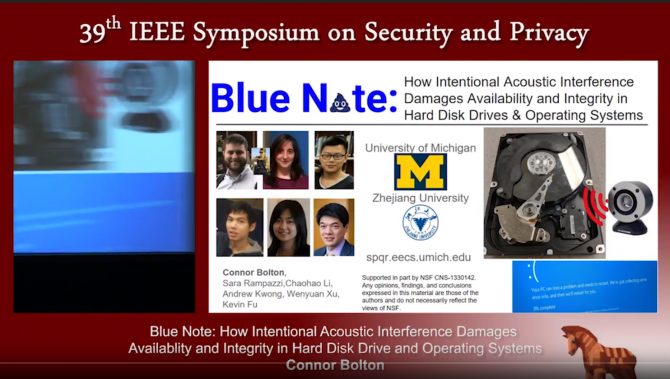Security researchers have demonstrated an acoustic attack on hard disk drives (HDDs) that can make a computer crash and lead to file system corruption. They also demonstrated how a security camera was unable to record video with a similar attack. The attack has been named BlueNote.

Researchers from the University of Michigan and Zhejiang University demonstrated the attack done during the IEEE Symposium on Security & Privacy held in San Francisco last week.
The acoustic attack works by sending out a (audible or inaudible ultrasound) signal on a specific frequency. The signal causes vibration, and in the worst case, can destroy an object. This works with hard disk drives because they contain several magnetic disks (platters) with read and write heads close to them. Platters contain the data. Read and write heads are responsible for reading and writing the data form and to the platters. Due to increasing data densities the heads have to operate very precisely, a small anomaly can cause malfunction or even (permanently) damage the heads or platters.
Nevertheless, magnetic discs are still used for important applications, such as medical and security equipment. Sudden moves can damage the HDDs and corrupt the data. Previous research indicates that even loud noises, like fire alarms can make hard disks vibrate in such a way that a device is damaged or becomes unresponsive.
“What remains a mystery is how and why intentional vibration causes bizarre malfunctions in HDDs and undefined behavior in operating systems,” according to the researchers. For their report (PDF) they analyzed how intentional vibrations on specific frequencies can cause permanent data loss, crashes and physical damages.
During the demonstration the researchers demonstrated how they could crash a Windows 10 laptop using the built-in speakers to send out an ultrasound signal. In another demonstration they showed how a security camera temporarily stops recording video by sending out a specific signal using a smartphone.
The researchers also investigated a solution to protect against an acoustic attack. They found that hard disks contain a 'feedback controller' that tries to make sure the read and write heads remain in the correct position. Currently, controllers are not programmed to detect attacks and to respond to them. Therefore, the researchers added some additional logic to the controller that provides information about the attack. With the new logic the controller is able to compensate movement of the heads caused by an acoustic attack. That's possible because the movement of the heads during an acoustic attack is predictable.
The logic can be added to hard disks with a firmware update, according to the researchers.
















